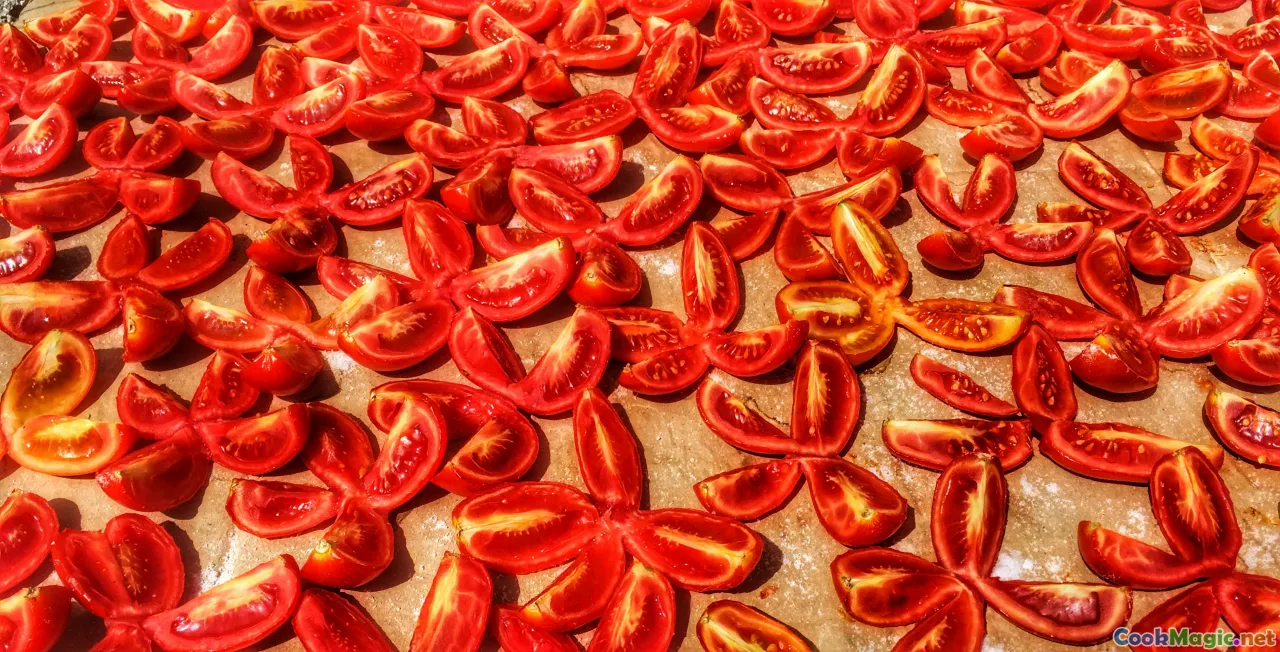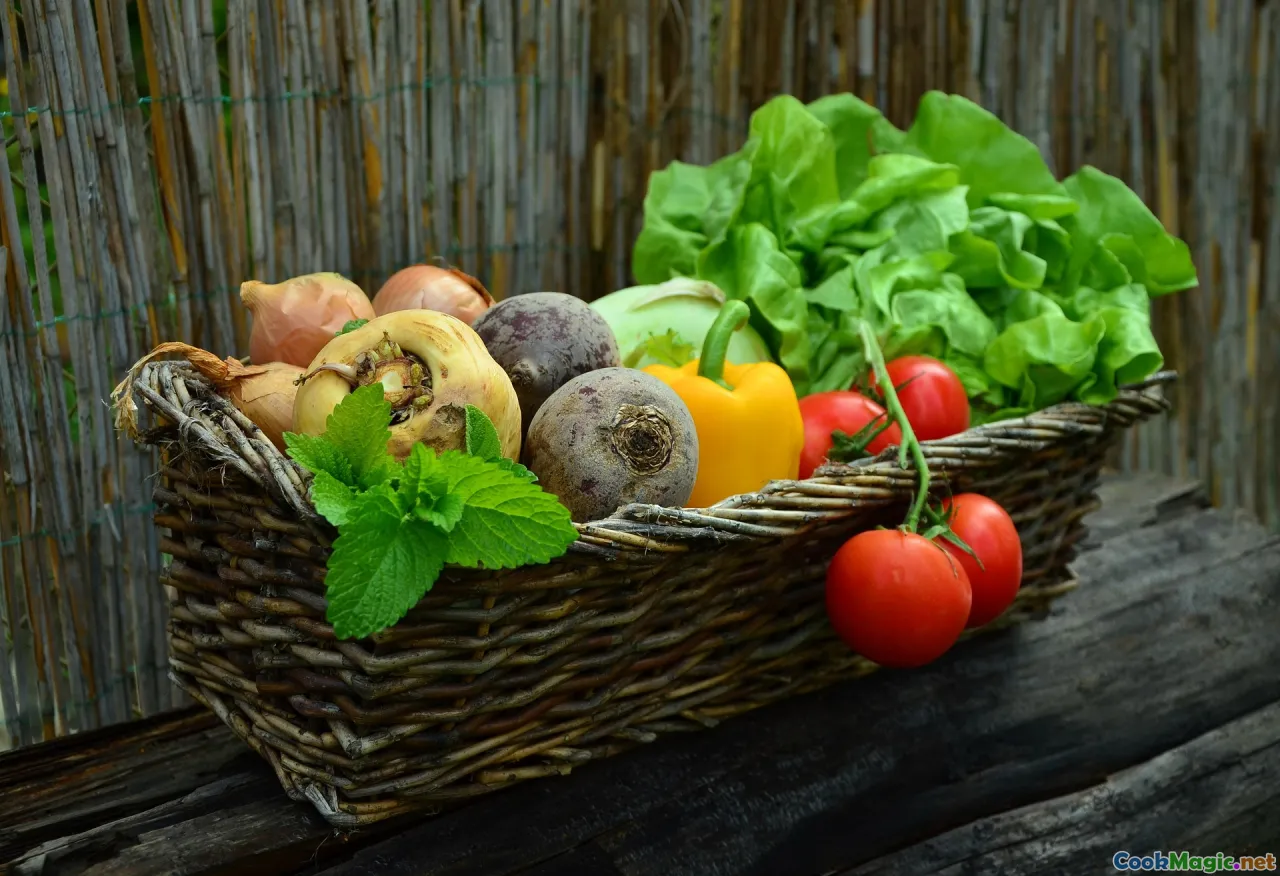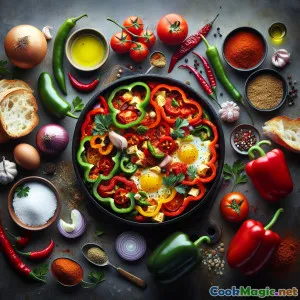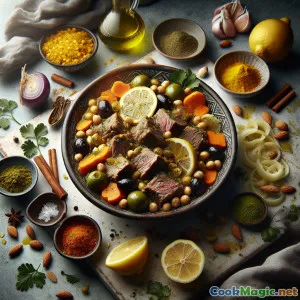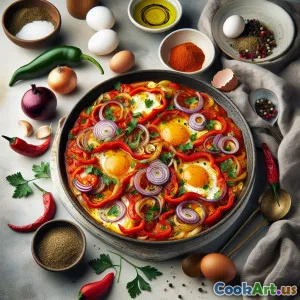
Marmouma de Médenine: Chảo Sahara rực lửa
(Marmouma de Médenine: Fiery Saharan Skillet)
(0 Đánh giá)0
149
tháng 10 11, 2025
Báo cáo sự cố
Nguyên liệu
-
45 ml Dầu ô liu nguyên chất
(Prefer Tunisian Chetoui or Chemlali for bold flavor)
-
1 medium Hành tây vàng, thái lát mỏng
(About 150 g)
-
4 cloves Tỏi tây, băm nhỏ
(Fresh and pungent)
-
2 medium Ớt chuông xanh, cắt thành dải
(For sweetness and body)
-
1 medium Ớt chuông đỏ, cắt thành dải
(Adds color and balance)
-
600 grams Cà chua chín, bỏ vỏ và băm nhỏ
(Substitute with canned crushed tomatoes if out of season)
-
1.5 tbsp Nước sốt cà chua
(Deepens umami and color)
-
1.5 tbsp bột ớt harissa
(Điều chỉnh theo khẩu vị về mức độ cay)
-
1 tsp Hạt ngò rí xay
(Key to Tunisian tabil aroma)
-
0.5 tsp Caraway xay mịn
(Classic Tunisian spice pairing)
-
1 tsp Ớt paprika ngọt
(Smoked paprika adds a rustic twist)
-
1 tsp muối biển mịn
(Điều chỉnh theo khẩu vị)
-
0.5 tsp Tiêu đen, xay mới
(Adds gentle warmth)
-
2 large Trứng
(Optional; for a shakshuka-style finish)
-
1 tbsp Vỏ chanh muối băm nhuyễn
(Bright citrusy complexity)
-
1 tbsp Nụ hoa caper đã ráo nước
(Salty pop that complements peppers)
-
2 tbsp Mùi tây lá phẳng tươi hoặc ngò rí, băm nhỏ
(For fresh finish)
-
200 grams Xúc xích merguez
(Optional; sear separately for a non-vegetarian version)
(Prefer Tunisian Chetoui or Chemlali for bold flavor)
(About 150 g)
(Fresh and pungent)
(For sweetness and body)
(Adds color and balance)
(Substitute with canned crushed tomatoes if out of season)
(Deepens umami and color)
(Điều chỉnh theo khẩu vị về mức độ cay)
(Key to Tunisian tabil aroma)
(Classic Tunisian spice pairing)
(Smoked paprika adds a rustic twist)
(Điều chỉnh theo khẩu vị)
(Adds gentle warmth)
(Optional; for a shakshuka-style finish)
(Bright citrusy complexity)
(Salty pop that complements peppers)
(For fresh finish)
(Optional; sear separately for a non-vegetarian version)
Dinh dưỡng
- Khẩu phần: 4
- Kích thước khẩu phần: 1 bát (300g)
- Calories: 180 kcal
- Carbohydrates: 0 g
- Protein: 4 g
- Fat: 10 g
- Fiber: 4 g
- Sugar: 8 g
- Sodium: 620 mg
- Cholesterol: 0 mg
- Calcium: 60 mg
- Iron: 1.8 mg
Hướng dẫn
-
1 - Prep the produce:
Slice onion and peppers into thin strips. Peel and chop tomatoes (or open canned). Mince garlic. If using preserved lemon, mince the rind.
-
2 - Optional pepper blistering:
For smoky depth, briefly blister pepper strips over a dry cast-iron skillet or over an open flame until lightly charred. Set aside.
-
3 - Sweat aromatics:
Warm olive oil in a wide skillet over medium heat. Add onion and a pinch of salt. Cook until translucent and sweet, 4–5 minutes. Stir in garlic for 1 minute.
-
4 - Bloom spices and paste:
Add tomato paste, coriander, caraway, paprika, and black pepper. Stir constantly to caramelize and bloom, about 60–90 seconds, until brick red and fragrant.
-
5 - Build the Sauce:
Add chopped tomatoes and harissa. Stir well, scraping fond. Bring to a gentle bubble.
-
6 - Simmer to jammy:
Reduce heat to medium-low. Simmer uncovered, stirring occasionally, until tomatoes thicken and glossy pockets of oil appear.
-
7 - Add peppers and season:
Fold in pepper strips (blistered or raw). Season with salt. Cook until peppers are tender but not mushy and the mixture is spoonable and thick.
-
8 - Finish with accents:
Stir in preserved lemon and capers if using. Taste and adjust salt, harissa, or a splash of olive oil for balance.
-
9 - Optional eggs or merguez:
For eggs: Make two small wells and crack eggs in. Cover and cook until whites set and yolks are runny, 4–6 minutes. For merguez: Sear separately until browned; serve over or alongside.
-
10 - Rest and Garnish:
Let the marmouma rest 2 minutes to settle. Sprinkle with chopped parsley or cilantro. Serve hot with warm flatbread or over couscous.
Slice onion and peppers into thin strips. Peel and chop tomatoes (or open canned). Mince garlic. If using preserved lemon, mince the rind.
For smoky depth, briefly blister pepper strips over a dry cast-iron skillet or over an open flame until lightly charred. Set aside.
Warm olive oil in a wide skillet over medium heat. Add onion and a pinch of salt. Cook until translucent and sweet, 4–5 minutes. Stir in garlic for 1 minute.
Add tomato paste, coriander, caraway, paprika, and black pepper. Stir constantly to caramelize and bloom, about 60–90 seconds, until brick red and fragrant.
Add chopped tomatoes and harissa. Stir well, scraping fond. Bring to a gentle bubble.
Reduce heat to medium-low. Simmer uncovered, stirring occasionally, until tomatoes thicken and glossy pockets of oil appear.
Fold in pepper strips (blistered or raw). Season with salt. Cook until peppers are tender but not mushy and the mixture is spoonable and thick.
Stir in preserved lemon and capers if using. Taste and adjust salt, harissa, or a splash of olive oil for balance.
For eggs: Make two small wells and crack eggs in. Cover and cook until whites set and yolks are runny, 4–6 minutes. For merguez: Sear separately until browned; serve over or alongside.
Let the marmouma rest 2 minutes to settle. Sprinkle with chopped parsley or cilantro. Serve hot with warm flatbread or over couscous.
Thông tin thêm về: Marmouma de Médenine: Chảo Sahara rực lửa
Marmouma de Médenine: A Southern Tunisian Pepper-Tomato Classic
Marmouma is a soulful, sun-drenched skillet from southern Tunisia—especially beloved around Médenine—where the Sahara’s edge meets the Mediterranean’s pantry. At its heart, the dish braises peppers and tomatoes in olive oil with harissa and the Tunisian spice duo of coriander and caraway, creating a glossy, jammy stew that’s deeply savory yet bright. You can enjoy it as a meatless main, as a mezze with warm flatbread, or crown it with eggs for a shakshuka-adjacent experience. In some households, merguez joins the party, adding smoky richness. This recipe captures the Médenine spirit: frugal, bold, and irresistibly aromatic.
Why this recipe stands out
- Balanced heat: Harissa provides warmth without overwhelming the vegetables; the sweetness of peppers and onions keeps it friendly.
- Jammy texture: Properly simmered tomatoes concentrate into a luscious base that clings to bread and spoons.
- Flexible finish: Keep it vegan, crack in eggs, or add seared merguez. The base remains the star.
- Pantry-smart: With canned tomatoes and jarred harissa, you can make marmouma year-round.
Technique tips for best results
- Sweat, don’t scorch: Take time to gently soften onions before adding garlic. This builds sweetness that balances harissa’s heat.
- Bloom the flavor: Stir-frying tomato paste with coriander, caraway, and paprika unlocks depth and a beautiful brick-red hue.
- Control moisture: Simmer uncovered to reduce to a spoonable, jammy consistency; look for glossy oil pooling around the edges.
- Optional blister: Lightly charring pepper strips adds a rustic smokiness reminiscent of wood-fired village kitchens.
- Season in layers: Salt early to draw moisture, then adjust at the end with preserved lemon and capers for briny brightness.
- Eggs last: If adding eggs, create small wells, cover, and cook gently so the base stays lush and the yolks remain runny.
Ingredient spotlight
- Harissa: Tunisia’s iconic chili paste ranges from smoky to citrusy depending on brand or region. Médenine cooks often prefer a medium heat level; add gradually and taste.
- Tabil (coriander-caraway): The coriander-caraway pairing is foundational to Tunisian cuisine, bringing warmth without heaviness. A pinch goes a long way.
- Olive oil: Tunisian Chetoui oil is robust and peppery—perfect for standing up to chilies and tomatoes.
- Preserved lemon: Not mandatory, but a teaspoon or two of minced rind delivers a fragrant, sunny lift.
Variations and make-it-yours
- Médenine market style: Add a handful of roughly chopped, sun-dried tomatoes to amplify umami.
- With merguez: Sear sausages separately until browned; slice and nestle into the stew just before serving.
- With eggs: Two eggs keep the dish breakfast-friendly; four makes it a complete dinner for a small family.
- Ultra-smoky: Use smoked paprika and blister both red and green peppers.
- Veg-forward: Add a diced zucchini in summer; it melts into the sauce and loves the harissa-spice backbone.
Serving suggestions
- Scoop with warm kesra (Tunisian semolina flatbread) or any crusty loaf.
- Spoon over fluffy couscous or bulgur for a substantial main.
- Plate as part of a mezze spread with olives, labneh, and a crisp salad.
- Finish with a drizzle of good olive oil and a sprinkle of herbs for freshness.
History and cultural notes
Marmouma belongs to a family of Tunisian pepper-tomato braises that reflect the country’s intersecting culinary currents: Amazigh roots, Mediterranean produce, and trans-Saharan spice routes. In Médenine and across the south, long sunlit days and arid winds favor peppers, tomatoes, and olives—the building blocks of marmouma. The technique echoes the region’s pragmatic cooking: a single pan, modest ingredients, and time, resulting in a dish fit for family tables and communal gatherings. While shakshuka has become internationally famous, marmouma is more pepper-forward and slightly thicker, with a spice profile anchored in coriander and caraway rather than cumin alone. In many homes, it’s a weeknight staple—economical yet celebratory, especially when shared with bread torn right at the table.
Practical tips and notes
- Heat management: Start with less harissa and build. Every harissa brand differs; taste as you go.
- Texture target: Marmouma should be thick enough to mound on a spoon. If watery, keep simmering; if too thick, splash in a little water or a dice of fresh tomato.
- Make-ahead: The base keeps 4–5 days refrigerated and tastes even better on day two. Eggs, if used, are best cooked to order.
- Freezing: Freeze the base (without eggs) for up to 2 months. Thaw overnight and rewarm gently.
- Dietary notes: Naturally gluten-free and vegan without eggs or merguez. Adjust salt if using preserved lemon and capers.
- Pairings: Mint tea or a crisp, citrusy white wine complements the dish’s warmth.
Personal thoughts
Marmouma is comfort with a little swagger. The first spoonful is a study in contrasts—sweet peppers, bright tomatoes, a whisper of smoke, and the satisfying warmth of harissa. It’s also a template: once you master the onion-sweat, spice-bloom, and slow-simmer, you can pivot with what the market offers. On a busy evening, I often skip the eggs, pile the marmouma onto thick toast, and call it dinner. When guests come, I add preserved lemon and capers for sparkle, and maybe pass a plate of seared merguez for those who want extra richness. Either way, the dish captures the Médenine sun in every bite: bold, generous, and unforgettable.


